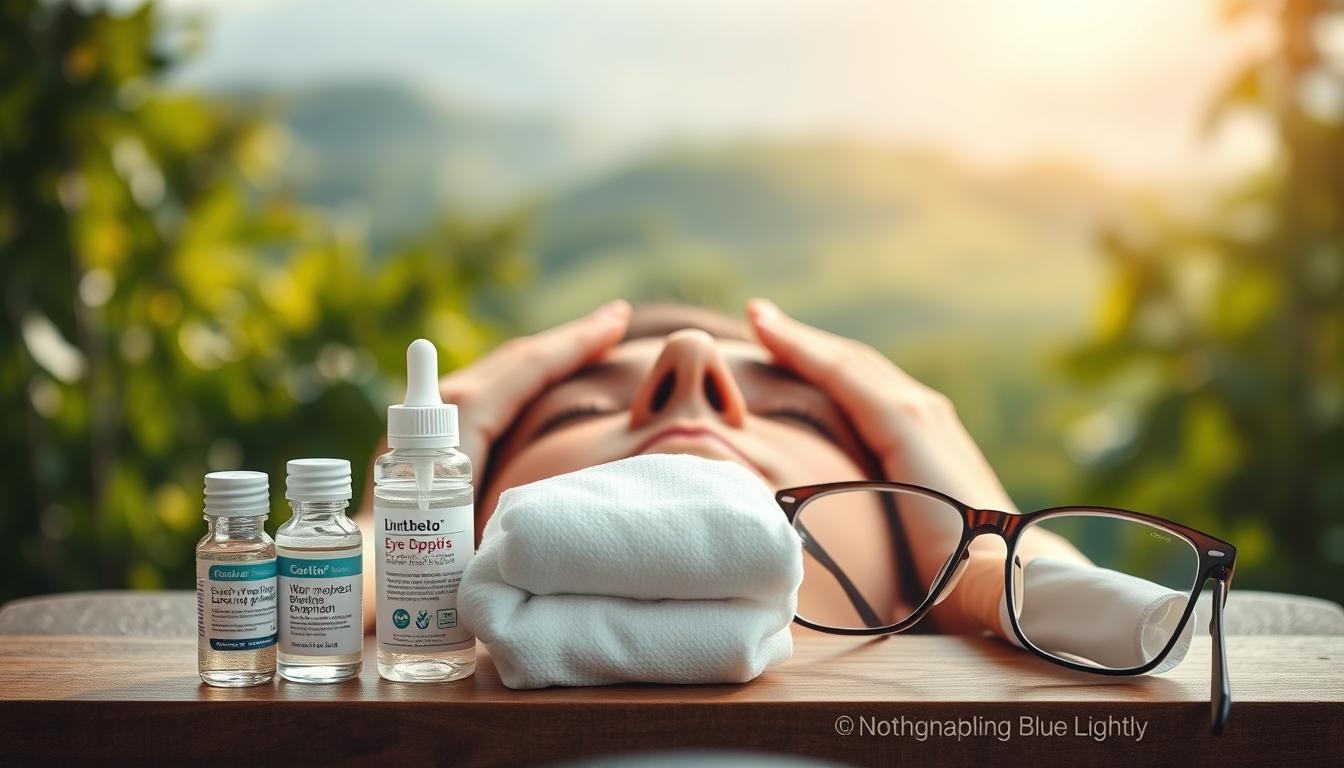Our modern lives are characterized by extensive screen time, changing the way we interact and experience the world. This can make our eyes sore and tired. But, there are simple ways to ease this discomfort. This article will show you how to take care of your eyes, even when you’re using devices a lot.
By following these easy tips, you can keep your eyes clear and focused all day. This is great for students, remote workers, and anyone who uses screens a lot.
Key Takeaways
- Understanding eye strain and its common symptoms is vital for prevention.
- Daily habits play a crucial role in protecting your eyes from screen fatigue.
- The 20-20-20 rule is an effective approach to relieving eye strain.
- Utilizing blue light filters can enhance your comfort during screen time.
- Practicing blinking exercises helps maintain eye moisture and alleviate discomfort.
- Creating an ergonomic workspace can significantly reduce digital fatigue.
Understanding Eye Strain and Its Symptoms
Eye strain is common today because of more screen time. Knowing what causes it and its symptoms helps with eye care. It also aids in recovering from mild visual strain.
Common Symptoms of Eye Strain
Eye strain can cause several symptoms, including:
- Dryness or irritation
- Fatigue after prolonged usage
- Blurred or double vision
- Headaches
- Difficulties in focusing
These symptoms often show up after long screen time without breaks or adjustments.
How Screens Contribute to Eye Strain
Devices like computers and phones emit blue light, leading to discomfort. Other factors include:
- Glare on the screen surface
- Inadequate distance between your eyes and the screen
- Inconsistent lighting conditions in your workspace
How often and how long you use screens affects eye fatigue. It’s important to have good viewing habits for eye care.

The Importance of Eye Wellness Habits
In today’s world, it’s key to add eye wellness habits to your daily life. These habits help prevent digital fatigue from too much screen time. Taking care of your eye health can have a positive impact on your work experience.
Daily Habits to Protect Your Eyes
Starting daily eye care habits can greatly protect your vision. Here are easy steps to follow:
- Try the 20-20-20 technique: take a 20-second break every 20 minutes to view something 20 feet away.
- Make sure your workspace has the right lighting to cut down on screen glare.
- Keep a safe distance from screens, ideally 20 to 30 inches away.
- Adequate hydration is essential for keeping your eyes healthy.
Creating a Comfortable Work Environment
Your workspace plays a big role in your eye health. To make it more comfortable, try these tips:
- Make sure your screen is at eye level by adjusting your chair and desk accordingly.
- Use anti-glare screen protectors to reduce reflections.
- Place your computer away from windows to avoid sunlight glare.
- Add plants or natural light to make your space feel better.
Natural Eye Strain Relief from Screen Use
Keeping your eyes comfortable while using screens is key to your health. The 20-20-20 rule is a simple way to help. It tells you to look away every 20 minutes at something 20 feet away for 20 seconds. This can really help ease eye strain.
Implementing the 20-20-20 Rule
The 20-20-20 rule is all about taking breaks. It lets your eyes relax by looking at something far away for a bit. Relaxing your eye muscles can help alleviate eye fatigue and discomfort.
Other Effective Natural Remedies
There are more ways to help tired eyes, aside from the 20-20-20 rule. Drinking water regularly can help maintain moisture and comfort in your eyes. Eating foods full of vitamins A, C, and E also helps your eyes stay healthy. Plus, using eye drops can make your eyes feel better if they’re dry.

Using Technology to Your Advantage
In today’s world, using technology can really help with eye strain from screens. By using blue light protection and adjusting your device settings, you can feel better. These steps can make your work or fun time on screens more comfortable.
Blue Light Filters and Their Benefits
Blue light filters are key to lessening screen harm. You can find them as software or physical screen protectors. Using them can help you stay focused and comfortable for longer periods.
Adjusting Screen Brightness and Contrast
Tweaking your screen’s brightness and contrast can make a big difference in comfort. Setting these right can make your screen time better. Adjust your screen’s brightness to match the lighting in your room to minimize glare.
Also, adjust contrast so text is clear. This can prevent eye tiredness. By following these tips, you can enjoy your screen time more.

Exercises and Techniques to Soothe Eye Discomfort
Regular eye exercises can help promote healthy vision and reduce eye strain. Blinking exercises help keep your eyes moist. Gentle techniques also promote eye relaxation. Both methods can ease eye discomfort from too much screen time, making you feel better all day.
Practicing Blinking Exercises
It’s key to blink often to keep your eyes hydrated. Here’s how to do blinking exercises right:
- Close your eyes gently for a moment.
- Open your eyes wide for a count of five.
Repeat this cycle for a minute, blinking slowly and on purpose.
This easy practice can help by adding tears and cutting down dryness. It’s great when you’ve been looking at screens for a long time.
Gentle Eye Relaxation Techniques
Along with blinking, there are other gentle ways to ease eye strain:
- Palming technique: warm your hands, then gently place them over your closed eyes to soothe them. Enjoy the darkness and warmth for a minute.
- Focus Shifting: Look away from your screen and focus on something far away. Hold this gaze for 20 seconds before looking back at your screen.
- Rotate your eyes in a circular motion, starting with clockwise and then switching to anticlockwise. This helps relax your eye muscles.
Using these gentle eye relaxation techniques can make watching things more comfortable. They help relax your eyes and lessen fatigue from screen time.
Simple Remedies for Dry Eyes from Screens
Dry eyes from screens are common, mainly for those who use digital devices a lot. Luckily, there are easy fixes to ease the discomfort. We’ll look at how artificial tear drops work and the benefits of a cold compress for tired eyes.
Artificial Tear Drops and Their Use
Artificial tear drops are a great way to add moisture and comfort to dry eyes. These drops are made to act like natural tears. They help lubricate your eyes and ease dryness or irritation. Here’s how to use them right:
- Wash your hands well before using the drops.
- Shake the bottle gently if needed.
- Pull down your lower eyelid to make a small pocket.
- Release one or two drops into the pocket, being careful not to touch the eye.
- Close your eyes for a bit to let the solution spread.
Cold Compress for a Refreshing Effect
Try applying a cold compress to ease eye fatigue. It can help reduce swelling and refresh your eyes, which is great after using screens for a long time. Here’s a simple guide to creating and using a cold compress::
- Soak a clean cloth in cold water or use a gel eye mask chilled in the fridge.
- Wring out any extra liquid to avoid dripping.
- Close your eyes and gently put the compress over your eyelids.
- Relax for about 10-15 minutes, letting the cold compress soothe your eyes.
Using these simple remedies can really help with dry eyes from screens. They provide much-needed relief and comfort.
Screen Posture Tips to Prevent Digital Fatigue
Creating an ergonomic workspace is key to staying comfortable during long screen times. Place your monitor so the top of the screen is at eye level or slightly below to minimize strain. This reduces body strain and prevents digital fatigue.
Optimal Screen Positioning
To get the best screen position, follow these tips:
- Position the top of your monitor at or slightly below eye level for optimal viewing.
- Sit about 50.8-76.2cm away from the screen for optimal viewing.
- Adjust the angle of your screen to reduce reflections and glare.
These steps help relax your neck and back, preventing discomfort while working.
Ergonomics in Your Workspace
Investing in ergonomic furniture is crucial for a healthy posture. Here are important elements to consider:
By setting up an ergonomic workspace, you improve your comfort and prevent digital fatigue. Adding thoughtful design to your daily routine boosts your well-being.
Conclusion
Taking care of your eyes is a top priority in modern life. This article has shown how screens can hurt your eyes and how to feel better. By changing your habits and using natural ways to ease eye strain, you can keep your eyes healthy.
Using the 20-20-20 rule, blue light filters, and good posture can help a lot. These steps not only ease eye pain but also protect your eyes for the long run. Taking care of your vision can fight the bad effects of too much screen time.
Make these tips a part of your daily life to keep your eyes happy and healthy. With the right steps, you can lessen eye strain and keep your vision clear. This way, you can enjoy digital technology without harming your eyes.






GIPHY App Key not set. Please check settings